Once primmed board or canvas can be painted over with a thin coat of diluted colour using a rag or a brush. That kind of a surface is called toned surface. Toning of the surface has two purposes first it helps you diminish the whiteness of the canvas or the board helping you determine the intensity of the colours you use because colours look much more intense when added to a white surface.
For example, the red colour looks much darker when its added to a white surface but as you progress with your work and add other colours it loses a lot on its intensity. A neutral surface of middle tone provides a much better surface to paint on so you can add all the tones with ease dark or light. That is the reason why it’s much easier painting with oil colours on
You can also leave areas of the surface visible between the layers of added colour thus creating the effect of harmony and connection between the added layers.
The choice of colour depends on the theme you choose but it should be the neutral tone somewhere in between the brightest and the lightest tones on the painting. Colour can be subtle so it doesn’t overpower the other colours that you’re adding on top of it like diluted Venetian Red, Raw Sienna, Burnt Umber along with some mild green or grey.
Applying the tone on the surface
Dilute the colour a lot using turpentine or odourless mineral spirits to get it to a very thin film and then apply it on the surface using a large brush. After a few minutes rub the paint with a clean rag leaving a transparent film of colour which is ready for painting the next day.
You must always make sure that the toned surface is completely dry before you start painting on it. Surface painted with oil colours usually gets dry after 24 hours.

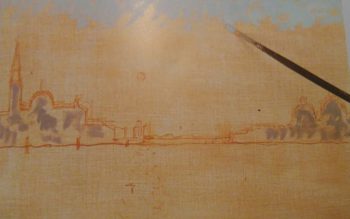
Evening in Venice
For painting this painting you will need the following:
- Primmed canvas
- Round sable bristle brush number 2
- Round hog bristle brush number 5
- Decorators brush 38mm
- Turpentine or odourless mineral spirits
- Linen oil
- Damar Varnish
- Raw Umber
- Burnt Sienna
- French Ultramarine
- Sky Blue
- Alizarin Red
- Cadmium Red
- Cadmium Orange
- Lemon Yellow
- Titanium White
- African Black
Cover the entire surface of the primed canvas with the transparent layer of Raw Umber which is diluted as much as possible with turpentine or odourless mineral spirits. To do so use decorators brush 38mm. The main objective is to minimize the whiteness of the primed canvas and establish the middle tone which will help you determine the lighter and the darker tones on your painting.
Leave it to dry overnight. For sketching the basic elements of the painting use round sable brush number 2 and a very diluted mixture of Raw Umber and Burnt Sienna. From now on you will mix the colours with a medium that consists of equal amounts of dammar varnish and linen oil and double amount of turpentine.
Mix warm grey using Raw Umber, French Ultramarine and Alizarine Red and ad it to the buildings in the distance using hog bristle brush number 5. Then mix Turquoise Grey, Ultramarine, White and a bit of Lemon Yellow and paint the upper part of the sky whit relaxed brush strokes leaving some areas uncoloured so that you can see the toned surface.
Continue colouring the sky with the same brush using the mixture of Ultramarine, Alizarin Red, Titanium White and a little bit of African Black adding layer after layer to get close to the line of the horizon. As you get close to the line of the horizon ad a little bit of Alizarin Red and more White to the mixture thus gradually creating a warm purple colour.
Again ad the colour with relaxed strokes leaving uncoloured areas on which you can see the colour of the base tone.
Building the composition
Start adding greenish tones into the water leaving the little area for the sunrays. Basic colours you shall use for that are Ultramarine, Lemon Yellow, Blue and White. Mix those in different proportions to get a strain of nuances of greenish-grey.
Ad to it a bit of blue for darker colder greens and a bit of yellow or white for brighter warmer nuances. Point out the glow of the distant water with a spread of pale green. Mix Lemon Yellow, Cadmium Orange and White and colour the sun. Use very thick spread of colour so it reflects the light.
With the mixture of Ultramarine, Alizarin and White paint the cold halo of blue-grey around the sun using relaxed moves following the round shape of the sun. This is just one example of how one colour can affect the other next to it. Yellow sun looks much brighter in contrast to the darker tone of the surrounding grey.
Paint the buildings on the left side of the painting with soft bluish purple grey colours mixed with different amounts of Ultramarine, Alizarine, Black and White. Use the grey tones you already have mixed on your pallet. Instead of filling the contours with even moves and equal spreads of paint use short strokes and ad the colour in dots leaving some areas of toned surface visible.
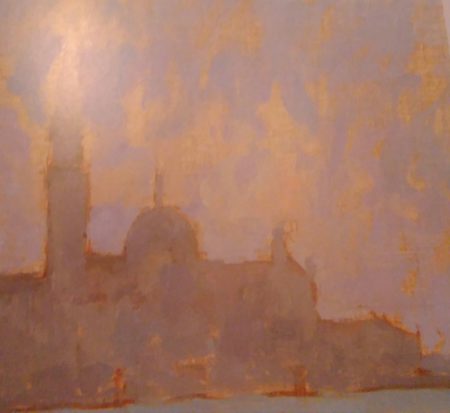
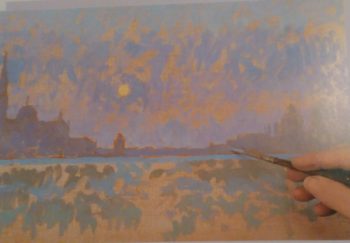
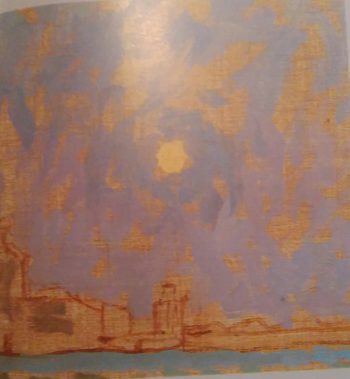
Finishing touches
Paint the sky on the horizon with the mixture of Cadmium Red, Lemon Yellow and a lot of White added with relaxed strokes. Now work on the buildings on the left side of the painting using the mixture you already used for the buildings in front of them, ad white to the mixture to create the effect of depth.
Mix Lemon Yellow, Orange and white and paint the scattered reflections of sun rays on the water. Use round sable bristle brush number 2 to paint rhythmical and strong moves depicting the waves on the surface. In order to emphasize the impression of space and perspective make short strokes of paint in the distance and also make them a bit lighter.
With the mixture of Ultramarine, Alizarin and a bit of Black paint the top part of the pillars sticking out from the water in the distance. Then use Ultramarine, Lemon Yellow and Cadmium Orange to paint little dark waves.
Determine the tone balance of the colours making sure nothing points out too much. The effect achieved should be misty evening light.
If you have any questions or need any additional explanations just leave them below and ill make sure to answer.



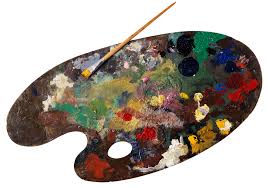
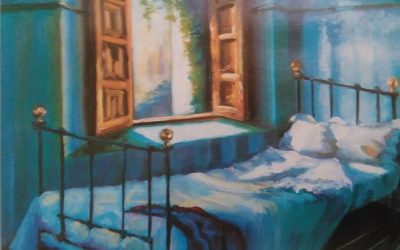
0 Comments